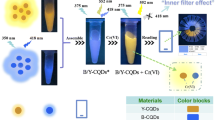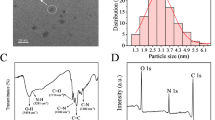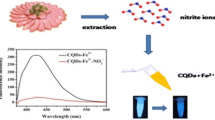Abstract
An optical method is described for the ratiometric fluorometric determination of cyanide ions. It is based on the use of a mixture of aqueous solutions of blue-emitting carbon dots (CDs) and red-emitting gold nanoclusters (AuNCs). The presence of cyanide reduces the red fluorescence of the AuNCs through the formation of a stable complex [Au(CN)2−]. The blue emission of the CDs, in contrast, stays constant. Hence, the color of fluorescence changes from red to purple to blue. The ratio of the fluorescence intensities located at 612 and 438 nm varies over a wide range, with 2 linear responses ranges (from 8 nM to 12.5 μM, and from 12.5 to 75 μM). The method was applied to the determination and visual discrimination of cyanide in food and drink samples.

A ratiometric method for determination of cyanide detection is described that is based on mixing carbon dots (CDs) and gold nanoclusters (AuCNs). The presence of cyanide reduces the red fluorescence of the AuNCs through the formation of a stable complex Au(CN)2−. The blue emission of the CDs, in contrast, stays constant. The fluorescence intensity ratios show linear response to cyanide with a concomitant red-purple-blue fluorescence color change.







Similar content being viewed by others
References
Wang F, Wang L, Chen X, Yoon J (2014) Recent progress in the development of fluorometric and colorimetric chemosensors for detection of cyanide ions. Chem Soc Rev 43:4312–4324
Chen Q, Zhu L, Chen J, Jiang T, Ye H, Ji H, Tsang S, Zhao Z, Yi T, Chen H (2019) Recent progress in nanomaterial-based assay for the detection of phytotoxins in foods. Food Chem 277:162–178
Mu JJ, Feng QY, Chen XD, Li J, Wang HL, Li MJ (2015) Silica nanoparticles doped with an iridium(III) complex for rapid and fluorometric detection of cyanide. Microchim Acta 182:2561–2566
Hallaj R, Haghighi N (2017) Photoelectrochemical amperometric sensing of cyanide using a glassy carbon electrode modified with graphene oxide and titanium dioxide nanoparticles. Microchim Acta 184:3581–3590
Amjadi M, Hassanzadeh J, Manzoori JL (2014) Determination of cyanide using a chemiluminescence system composed of permanganate, rhodamine B, and gold nanoparticles. Microchim Acta 181:1851–1856
Li Z, Liu C, Wang SJ, Xiao LW, Jing XM (2019) Visual detection of cyanide ion in aqueous medium by a new chromogenic azo-azomethine chemosensor. Spectrochim Acta A 210:321–328
Niu QF, Lan LX, Li TD, Guo ZR, Jiang T, Zhao ZY, Feng ZS, Xi JY (2018) A highly selective turn-on fluorescent and naked-eye colorimetric sensor for cyanide detection in food samples and its application in imaging of living cells. Sensor Actuat B-Chem 276:13–22
Dalapati R, Nandi S, Reinsch H, Bhunia BK, Mandal BB, Stock N, Biswas S (2018) Fluorogenic naked-eye sensing and live-cell imaging of cyanide by a hydrazine-functionalized CAU-10 metal-organic framework. CrystEngComm 20:4194–4201
Long LL, Huang MY, Wang N, Wu YJ, Wang K, Gong AH, Zhang ZJ, Sessler JL (2018) A mitochondria-specific fluorescent probe for visualizing endogenous hydrogen cyanide fluctuations in neurons. J Am Chem Soc 140:1870–1875
Maity D, Vyas G, Bhatt M, Paul P (2015) Detection of NaCN in aqueous media using a calixarene-based fluoroionophore containing ruthenium(II)-bipyridine as the fluorogenic unit. RSC Adv 5:6151–6159
Qing Z, Hou L, Yang L, Zhu L, Yang S, Zheng J, Yang R (2016) A reversible nanolamp for instantaneous monitoring of cyanide based on an Elsner-like reaction. Anal Chem 88:9759–9765
Wang Y, Kim SH, Feng L (2015) Highly luminescent N, S-co-doped carbon dots and their direct use as mercury(II) sensor. Anal Chim Acta 890:134–142
Bagheri N, Djafarzadeh N, Hassanzadeh J (2016) Inhibition of rhodamine B-ferricyanide chemiluminescence by gold nanoparticles and sensitive determination of hazardous cyanide. Anal Sci 32:317–322
Lien CW, Unnikrishnan B, Harroun SG, Wang CM, Chang JY, Chang HT, Huang CC (2018) Visual detection of cyanide ions by membrane-based nanozyme assay. Biosens Bioelectron 102:510–517
Lou YB, Zhao YX, Zhu JJ (2016) Ultrasensitive optical detection of anions by quantum dots. Nanoscale Horiz 1:125–134
Lim SJ, Ma L, Schleife A, Smith AM (2016) Quantum dot surface engineering: toward inert fluorophores with compact size and bright, stable emission. Coord Chem Rev 320:216–237
Wu P, Zhao T, Wang SL, Hou XD (2014) Semicondutor quantum dots-based metal ion probes. Nanoscale 6:43–64
Ding CQ, Zhu AW, Tian Y (2014) Functional surface engineering of C-dots for fluorescent biosensing and in vivo bioimaging. Acc Chem Res 47:20–30
Wang J, Li RS, Zhang HZ, Wang N, Zhang Z, Huang CZ (2017) Highly fluorescent carbon dots as selective and visual probes for sensing copper ions in living cells via an electron transfer process. Biosens Bioelectron 97:157–163
Zhang LB, Wang EK (2014) Metal nanoclusters: new fluorescent probes for sensors and bioimaging. Nano Today 9:132–157
Wu JP, Jiang KL, Wang XJ, Wang CX, Zhang C (2017) On-off-on gold nanocluster-based near infrared fluorescent probe for recognition of Cu(II) and vitamin C. Microchim Acta 184:1315–1324
Tian L, Li YF, Ren TT, Tong YL, Yang BS, Li YQ (2017) Novel bimetallic gold-silver nanoclusters with "synergy"-enhanced fluorescence for cyanide sensing, cell imaging and temperature sensing. Talanta 170:530–539
Wang CW, Chen YN, Wu BY, Lee CK, Chen YC, Huang YH, Chang HT (2016) Sensitive detection of cyanide using bovine serum albumin-stabilized cerium/gold nanoclusters. Anal Bioanal Chem 408:287–294
Long Y, Zhou J, Yang MP, Liu XJ, Zhang M, Yang BQ (2016) Highly selective, sensitive and naked-eye fluorescence probes for the direct detection of hypochlorite anion and their application in biological environments. Sensor Actuat B-Chem 232:327–335
Chen AM, Peng X, Pan ZF, Shao K, Wang J, Fan MH (2018) Visual assay of glutathione in vegetables and fruits using quantum dot ratiometric hybrid probes. J Agric Food Chem 66:6431–6438
Huang XY, Zhou YJ, Liu C, Zhang RL, Zhang LY, Du SH, Liu BH, Han MY, Zhang ZP (2016) A single dual-emissive nanofluorophore test paper for highly sensitive colorimetry-based quantification of blood glucose. Biosens Bioelectron 86:530–535
Wang J, Peng X, Li DQ, Jiang XC, Pan ZF, Chen AM, Huang L, Hu J (2018) Ratiometric ultrasensitive fluorometric detection of ascorbic acid using a dually emitting CdSe@SiO2@CdTe quantum dot hybrid. Microchim Acta 185:42–50
Yan YH, Sun J, Zhang K, Zhu HJ, Yu H, Sun MT, Huang DJ, Wang SH (2015) Visualizing gaseous nitrogen dioxide by ratiometric fluorescence of carbon nanodots-quantum dots hybrid. Anal Chem 87:2087–2093
Snee PT (2018) The role of colloidal stability and charge in functionalization of aqueous quantum dots. Acc Chem Res 51:2949–2956
Wang J, Ma M, Huang RB, Wang LG, Chen AM, Hu J (2015) An efficient ratiometric fluorescent probe based on dual-emission fluorescent silica nanoparticles for visual determination of Hg2+. Anal Methods 7:2295–2299
Zhou YJ, Huang XY, Liu C, Zhang RL, Gu XL, Guan GJ, Jiang CL, Zhang LY, Du SH, Liu BH, Han MY, Zhang ZP (2016) Color-multiplexing-based fluorescent test paper: dosage-sensitive visualization of arsenic(III) with discernable scale as low as 5 ppb. Anal Chem 88:6105–6109
Wang XY, Yu SM, Liu W, Fu LW, Wang YQ, Li JH, Chen LX (2018) Molecular imprinting based hybrid ratiometric fluorescence sensor for the visual determination of bovine hemoglobin. ACS Sens 3:378–385
Liu X, Li B, Xu Y, Li ZQ, Zhang Y, Ding ZJ, Cui H, Wang J, Hou HB, Li HR (2019) A highly selective lanthanide-containing probe for ratiometric luminescence detection of an anthrax biomarker. Dalton Trans 48:7714–7719
Xu SF, Lu HZ (2016) Mesoporous structured MIPs@CDs fluorescence sensor for highly sensitive detection of TNT. Biosens Bioelectron 85:950–956
Tao Y, Lin YH, Ren JS, Qu XG (2013) A dual fluorometric and colorimetric sensor for dopamine based on BSA-stabilized Au nanoclusters. Biosens Bioelectron 42:41–46
Liu C-Y, Tseng W-L (2012) Using polysorbate 40-stabilized gold nanoparticles in colorimetric assays of hydrogen cyanide in cyanogenic glycoside-containing plants. Anal Methods 4:2537–2542
Mannel-Croise C, Probst B, Zelder F (2009) A straightforward method for the colorimetric detection of endogenous biological cyanide. Anal Chem 81:9493–9498
Zhu SJ, Meng QN, Wang L, Zhang JH, Song YB, Jin H, Zhang K, Sun HC, Wang HY, Yang B (2013) Highly photoluminescent carbon dots for multicolor patterning, sensors, and bioimaging. Angew Chem Int Ed 52:3953–3957
Raut S, Chib R, Rich R, Shumilov D, Gryczynski Z, Gryczynski I (2013) Polarization properties of fluorescent BSA protected Au25 nanoclusters. Nanoscale 5:3441–3446
Chevrier DM, Thanthirige VD, Luo Z, Driscoll S, Cho P, MacDonald MA, Yao Q, Guda R, Xie J, Johnson ER, Chatt A, Zheng N, Zhang P (2018) Structure and formation of highly luminescent protein-stabilized gold clusters. Chem Sci 9:2782–2790
Rajamanikandan R, Ilanchelian M (2018) Protein-localized bright-red fluorescent gold nanoclusters as cyanide-selective colorimetric and fluorometric nanoprobes. ACS Omega 3:14111–14118
Wei SC, Hsu PH, Lee YF, Lin YW, Huang CC (2012) Selective detection of iodide and cyanide anions using gold-nanoparticle-based fluorescent probes. ACS Appl Mater Interfaces 4:2652–2658
Liu CL, Wu HT, Hsiao YH, Lai CW, Shih CW, Peng YK, Tang KC, Chang HW, Chien YC, Hsiao JK, Cheng JT, Chou PT (2011) Insulin-directed synthesis of fluorescent gold nanoclusters: preservation of insulin bioactivity and versatility in cell imaging. Angew Chem Int Ed 50:7056–7060
Lu DT, Liu LL, Li FX, Shuang SM, Li YF, Choi MMF, Dong C (2014) Lysozyme-stabilized gold nanoclusters as a novel fluorescence probe for cyanide recognition. Spectrochim Acta A 121:77–80
Liu Y, Ai K, Cheng X, Huo L, Lu L (2010) Gold-nanocluster-based fluorescent sensors for highly sensitive and selective detection of cyanide in water. Adv Funct Mater 20:951–956
Xie JP, Zheng YG, Ying JY (2009) Protein-directed synthesis of highly fluorescent gold nanoclusters. J Am Chem Soc 131:888–889
Song SW, Hidajat K, Kawi S (2005) Functionalized SBA-15 materials as carriers for controlled drug delivery: influence of surface properties on matrix-drug interactions. Langmuir 21:9568–9575
Peng ZG, Hidajat K, Uddin MS (2004) Adsorption of bovine serum albumin on nanosized magnetic particles. J Colloid Interface Sci 271:277–283
Folkesson B (1973) ESCA studies on the charge distribution in some dinitrogen complexes of rhenium, iridium, ruthenium, and osmium. Acta Chem Scand 27:287–302
Bodläender G (1896) Die chemie des cyanidverfahrens. Angew Chem 9:583–587
Chen FY, Zhao X, Liu HJ, Qu JH (2014) Reaction of Cu(CN)3 2− with H2O2 in water under alkaline conditions: cyanide oxidation, Cu+/Cu2+ catalysis and H2O2 decomposition. Appl Catal B Environ 158:85–90
Sarla M, Pandit M, Tyagi DK, Kapoor JC (2004) Oxidation of cyanide in aqueous solution by chemical and photochemical process. J Hazard Mater 116:49–56
Wiggins-Camacho JD, Stevenson KJ (2011) Indirect electrocatalytic degradation of cyanide at nitrogen-doped carbon nanotube electrodes. Environ Sci Technol 45:3650–3656
Acknowledgements
The authors gratefully acknowledge the financial support from National Natural Science Foundation of China (21875218, 21501191, 51672248 and 51872261) and Zhejiang Provincial Natural Science Foundation (LR19E020002).
Author information
Authors and Affiliations
Corresponding author
Ethics declarations
Conflict of interest
The author(s) declare that they have no competing interests.
Additional information
Publisher’s note
Springer Nature remains neutral with regard to jurisdictional claims in published maps and institutional affiliations.
Electronic supplementary material
ESM 1
(DOCX 2529 kb)
Rights and permissions
About this article
Cite this article
Wang, J., Qiu, Y., Li, D. et al. Ratiometric fluorometric and visual determination of cyanide based on the use of carbon dots and gold nanoclusters. Microchim Acta 186, 809 (2019). https://doi.org/10.1007/s00604-019-3803-0
Received:
Accepted:
Published:
DOI: https://doi.org/10.1007/s00604-019-3803-0




